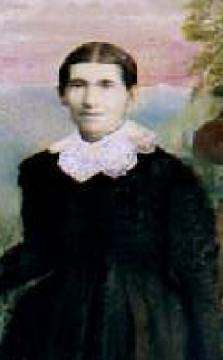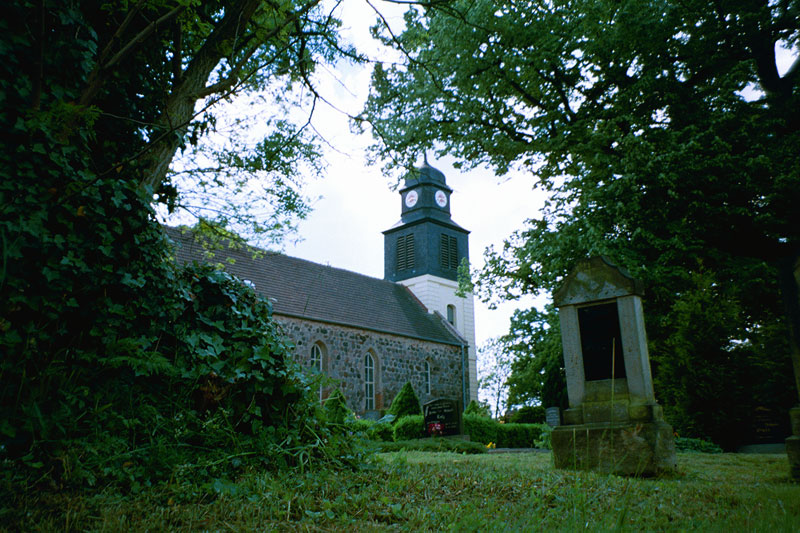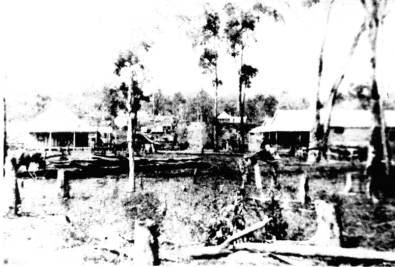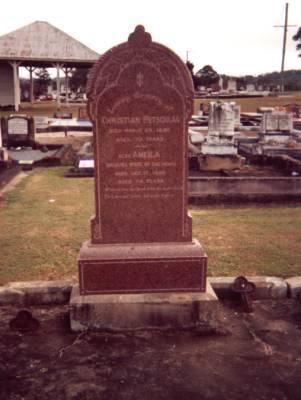
This block will be replaced by LeftMenuGaffey (orByrnes) when the page is served from a server.

- Father:
- Peter Leider[1]
- Mother:
- Johanna Christine Rohloff
- Birth:
- Dec 26 1835 in Blankenburg, Brandenburg, Germany
- Immigration::
- to Australia, 1863
- Death:
- Dec 17 1908 in Engleburn, Fassifern (near Marburg, Q) (age 74)
- Marriage:
- Christian Retchslag (1862, Blankenburg, Brandenburg, Prussia)
- Children:
- Wilhelm Friedrich Retschlag (1862-1863)
- (second son, died in Germany before 1863)
- Christian Retchslag (Jan 25 1865-Feb 8 1865)
- Emilie Christine Retchslag (Jan 25 1865-Feb 6 1865)
- Friedrich Retchslag (Jul 11 1866-Feb 24 1935)
- Zara Wilhelmina Retchslag (Nov 11 1868-Feb 2 1869)
- Emilia Wilhelmina Retchslag (Jun 11 1870-May 21 1871)
- Amalia
Christina Retchslag (Oct 5 1871 - Sept 15, 1903,
married
William Dance 1888 at Walloon, near Marburg - Meana Retchslag (May 30 1873-Jun 6 1873)
- Annie Retchslag (Apr 28 1874 -)
- Carl Retchslag (Jul 19 1876-Aug 27 1956)
- Amelia Retchslag (bef Jan 22 1878-Jan 22 1878)
- Anna Retchslag (Jul 22 1879-Dec 30, 1948)
A province of the Prussian Empire, Brandenburg in the 1800s covered 44 counties (Kreis) and stretched from the Elbe River to beyond the Oder River into modern Poland. This was the area where Emilie was born in 1833, and where she grew up.
 left:
The church in Blankenburg, East Germany where Emilie and
Christian Retschlag were married in 1860.
left:
The church in Blankenburg, East Germany where Emilie and
Christian Retschlag were married in 1860.Emilie and her husband Christian Retschlag were the first of our German ancestors to arrive in Australia, starting out in the German settlement at Nundah on Moreton Bay, after their arrival from Hamburg in 1864 on the maiden voyage of Susannah Godeffroy.
The young couple, who had only been married for four years, had already lost two infant sons in their home country, and their new country did not much bring much early joy to would-be parents. Another two children, twins, died a day apart at Nundah station within two weeks of their birth.
Emilie gave birth to at least 13 children, but only four of them were to grow to adulthood.
They stayed at Nundah for four years, enduring at least one other child death, Only one child from this period, a son Frederick, survived.
In 1868, the state government passed another Land Act, this time opening the Rosewood Scrub area west of Ipswich, to selectors. So, five years after their arrival, Christian and Emilie ventured on to the land west of Ipswich, to their first selection at Vernor, near Lowood. This move was swiftly cancelled in favour of another block, of 106 acres at Fernvale. This, too, Christian also amended, finally on March 31, 1870, applying for 80 acres in the Walloon Scrub, near the embryonic village of Marburg. The area later became known as Kirchheim, before it lost its Germanic name in the hysteria of World War 1 to become the more patriotic Haigslea.

Many of the German settlers of the 1870s in the Marburg Valley of southern Queensland came from the villages of the Brandenburg area of East Prussia, so perhaps the arrival there of Emilie and Christian was not as friendless as a new start in a remote land might have been for the young couple.

The birth of the raw pioneer township of Marburg, as Emilie and family would have found it in the 1870s.
Life could not have been easy, for a farmer’s wife in the Rosewood Scrub. As one researcher has described it:
 During
these first years cooking was done on an open fireplace. Two forked
saplings were set into the ground, one each side of the fireplace,
with a stout green sapling cross piece set high enough about the
fire to prevent it catching on fire. Pieces of wire were attached to
the sapling with hooks to hang bills and tins for boiling water and
cooking meals. Iron bars placed on bricks used to hold cast iron
saucepans, kettles and boilers over the fire. Camp ovens made of
cast iron with cast iron lids, a hinged handle and short stout legs
stood in the fire or hung by the handle on a steel hook attached to
the sapling. Dampers served as bread.[2]
During
these first years cooking was done on an open fireplace. Two forked
saplings were set into the ground, one each side of the fireplace,
with a stout green sapling cross piece set high enough about the
fire to prevent it catching on fire. Pieces of wire were attached to
the sapling with hooks to hang bills and tins for boiling water and
cooking meals. Iron bars placed on bricks used to hold cast iron
saucepans, kettles and boilers over the fire. Camp ovens made of
cast iron with cast iron lids, a hinged handle and short stout legs
stood in the fire or hung by the handle on a steel hook attached to
the sapling. Dampers served as bread.[2]
It was subsistence farming at its best – or worst. Poverty, even starvation, was never far away, particularly in the first few years after taking up a selection. Most settlers couldn’t have afforded the fare to Australia without the Government immigration scheme, and arrived with little or no money.
When cash was needed the settlers carried their produce to Ipswich. Home- made butter was popular at 8 pence a pound, gooseberries 3 pence a pound…..
….For these original settlers life was extremely difficult and harsh… the hardships and tragedies endured in particular by the pioneer women and their children are reflected in the number of children’s graves which lie in the district’s cemeteries.[3]
[1] Details on Emilie’s parents, birth, and death have come from Emilie’s death certificate, or that of her husband Christian; marriage details from: "Germany, Brandenburg and Posen, Church Book Duplicates, 1794-1874," index, FamilySearch (https://familysearch.org/pal:/MM9.1.1/J46D-MQ2 :), Christian Friedrich Retschlag (1862)
[2] Fred Kleidon, quoted by Frank Snar, German Settlement in the Rosewood Scrub: A Pictorial History, Rosewood Scrub Historical Society, 1997
[3] As above